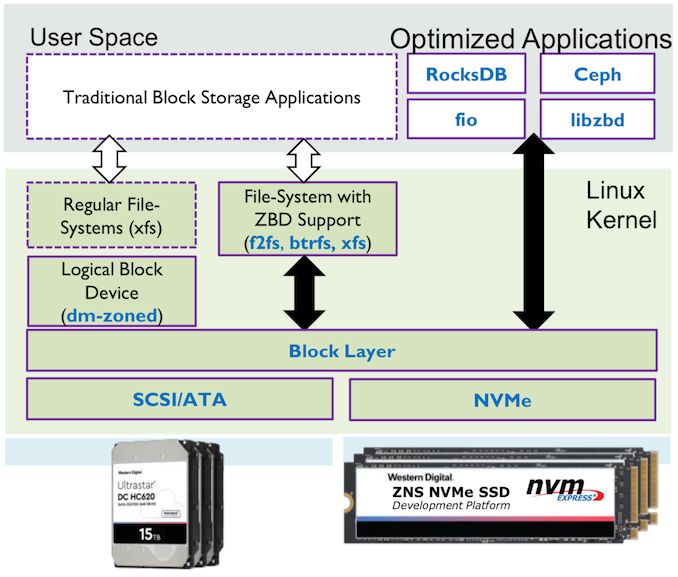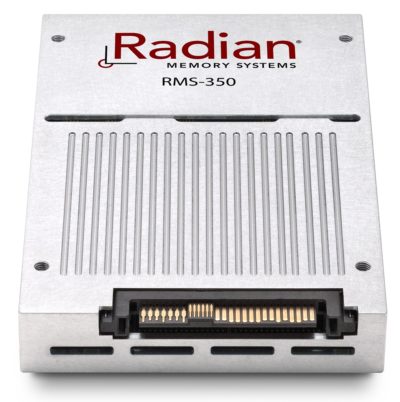The Next Step in SSD Evolution: NVMe Zoned Namespaces Explained
by Billy Tallis on August 6, 2020 12:00 PM EST- Posted in
- SSDs
- Storage
- Western Digital
- NVMe
- SMR
- Radian Memory
Ecosystem Status: Users and Use Cases
The software changes required, both in firmware and OS support/software, will keep zoned SSDs in the datacenter for the foreseeable future. Most of the early interest and adoption will be with the largest cloud computing companies that have the resources to optimize their software stacks top to bottom for zoned storage. But a lot of software work has already been done: software targeting host-managed SMR hard drives or open-channel SSDs can be easily extended to also support zoned SSDs. This includes both applications and filesystem drivers that have been modified to work on devices that do not support in-place modification of data.
Linux Kernel version 5.9 will update the NVMe driver with ZNS support, which plugs in to the existing zoned block device framework. Multiple Linux filesystems either already support running directly on zoned devices, or such support has been developed but not yet merged into a stable kernel release. The device mapper framework already includes a component to emulate a regular block device on top of a zoned device like a ZNS SSD, so unmodified filesystems and applications can be used. Western Digital has released a userspace library to help applications interact directly with zoned devices without using one of the kernel's filesystems on the device.
Only a few applications have publicly released support for ZNS SSDs. The Ceph clustered storage system has a backend that supports zoned storage, including ZNS SSDs. Western Digital has developed a zoned storage backend for the RocksDB key-value database (itself used by Ceph), but the patches are still a work in progress. Samsung has released a cross-platform library for accessing NVMe devices, with support for ZNS SSDs. They've written their own RocksDB backend using this library. As with host-managed SMR hard drives, most production use of ZNS (at least early on) will be behind the scenes in large datacenters. Because ZNS gives the host system a great degree of control over data placement on the SSD, it allows for good isolation of competing tasks. This makes it easier to ensure good storage performance QoS in multi-tenant cloud environments, but the relative lack of zone-aware software means there isn't much demand for such a hosting environment yet.
The most enthusiastic and prolific supporter of ZNS and zoned storage in general has been Western Digital, which stands to benefit from the overlap between ZNS and SMR hard drives. But it is very much a multi-vendor effort. The ZNS standard lists authors from all the other major NAND flash manufacturers (Samsung, Intel, Micron, SK Hynix, Kioxia), controller vendors (Microchip), cloud computing hyperscalers (Microsoft, Alibaba), and other familiar names like Seagate, Oracle and NetApp.
Longtime zoned SSD provider Radian Memory recently published a case study conducted with IBM Research. They ported an existing software-based log-structured storage system to run on Radian's non-standard zoned SSDs, and measured significant improvements to throughput, QoS and write amplification compared to running on a block storage SSD.
Most SSD vendors have not yet announced production models supporting ZNS (Radian Memory being the exception), so it's hard to tell what market segments, capacities and form factors will be most common among ZNS SSDs. The most compelling opportunity is probably for ZNS-only QLC based drives with reduced DRAM and overprovisioning, but the earliest models to market will probably be more conventional hardware configurations with updated firmware supporting ZNS.
Overall, ZNS is one of the next steps in mirroring the use of SSDs in the way SSDs are actually designed, rather than an add-on to hard drive methodology. It is a promising new feature. It looks likely to see more widespread adoption than previous efforts like open-channel SSDs, and the cost and capacity advantages should be more significant than what SMR hard drives have offered relative to CMR hard drives.












45 Comments
View All Comments
WorBlux - Wednesday, December 22, 2021 - link
> Kinda seems like they introduced a whole new problem, there?Sort of, many of these drives are meant to be used with the API's directly accessible to your application. Which means the application now has to solve problems that the OS hand-waved away.
If your application uses the filesystem API, only the filesystem has to worry about this. But if you want to application to leverage the determinism and parallelism available in the ZNS drives then it should be able to leverage the zone append command (which is the big advance over the zbc api of SMR hard drives)
Steven Wells - Saturday, August 8, 2020 - link
So as a DRAM cost play this might save low single percentage point savings of the parts costs which seems like not enough motivation to consider. So clearly most the savings comes from reduced over provisioning of the flash needed to get get a similar write application and trading that against the extra lift required by the host. Curious if anyone has shared TCO studies on this to validate a clear cost savings for all the heavy lifting required by both drive and data center customer.matias.bjorling - Monday, August 10, 2020 - link
Thanks for the comprehensive write-up, Billy. It's great to see you writing about ZNS on Anandtech - I've followed it for 20 years! I haven't thought that my work on creating Open-Channel SSDs and Zoned Namespaces would one day be featured on Anandtech. Thanks for making it mainstream!umeshm - Monday, August 24, 2020 - link
This is the best explanation and analysis I have found on ZNS. Thank you, Billy!I have a question about how 4KB LBAs are persisted when the flash page size is 16KB and when 4 pages (QLC) are stored on each wordline.
You mentioned that a 4KB LBA is partially programmed into flash page, but is vulnerable to read disturb. But my understanding so far is that only SLC supports partial-page programming. So a 4KB LBA would need to be buffered in NVRAM within the SSD until there is a full page (16KB) worth of data to write to a page. Then, the wordline is partially programmed, because the 3 other pages have not been programmed yet, so the wordline still needs to be protected through additional caching or buffering in NVRAM.
Could you or someone else please either confirm or correct my understanding?
Again, I really appreciate the effort and thinking that has gone into this article.
Umesh
weilinzhu - Monday, June 20, 2022 - link
very helpful article, thanks a lot! As you wrote: "A recent Western Digital demo with a 512GB ZNS prototype SSD showed the drive using a zone size of 256MB (for 2047 zones total) but also supporting 2GB zones." could you please kindly tell me where it was published! thanks in advance!!